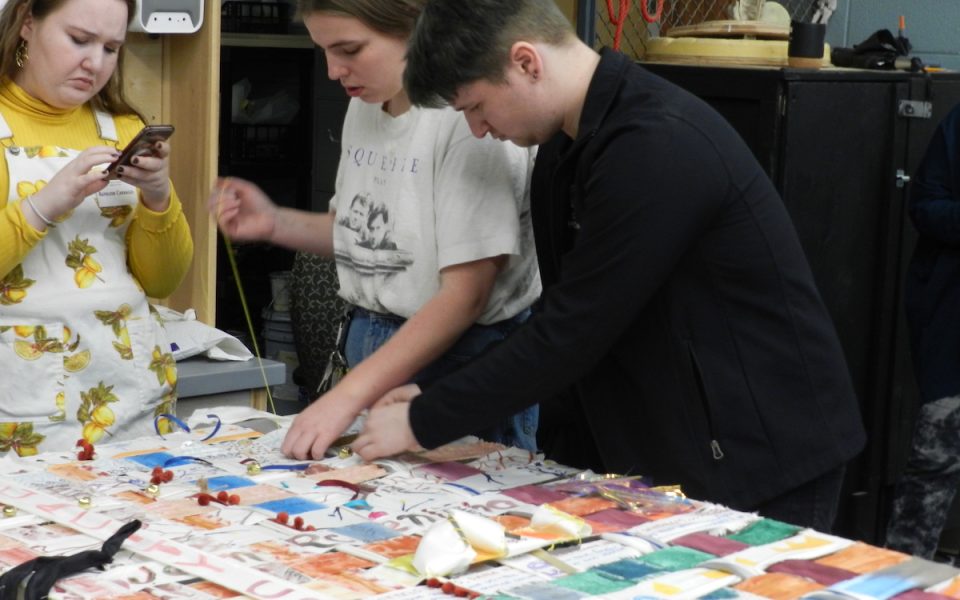The frame starts off empty.
Bit by bit, strips of fabric fill a corner, and then on one side; a pattern emerges. A student grabs a piece lined with red trim and pom poms, looping it over and under, as another student holds the end down. Once it stretches from one side to the other, a quick set of staples secures it into the artwork.
The weaving culminates the final event of UNCSA’s School of Design and Production’s Weekend of Women+. As Saturday morning moves on, established women in the arts sit face-to-face with students, creating collaborative pieces in a trio of makerspaces.
Bottles of paint, brushes and sponges sit beside fabric trims, embroidery floss and packs of needles. Whether student, faculty or guest artist, each person who enters one of the three rooms decorates a long strip of beige fabric. When completed, they weave the fabrics together, creating a quilt-like collage representing the past, present and future of women and gender inclusivity in professional art.
“This is a weekend of women, not a weekend for women,” Professor Molly McCarter says. “All genders are welcome and included here.”
McCarter, a professor of stage management for the college, pitched the idea soon after being hired at UNCSA. Though the School of Design and Production student body is 60 percent female, the professional fields remain vastly male-dominated. Due to the difference in the college’s environment and that of the professional art world, Dean Michael Kelley along with the rest of the college’s faculty rallied around the idea to host a weekend of panels, lectures and collaborative creation.
In the first of three rooms, guest artists, faculty and students must work with the prompt of describing the past. Roma Flowers, one of the guest artists and an award-winning lighting designer, sits at a large table with a group of students. Flowers stitches together a bundle of iridescent material and speaks of women who have passed down their knowledge. She attaches the holographic texture to the frame on a strip where she painted out the name “Jean Rosenthal.”
“She is the mother of lighting design,” Flowers explains, then points to another piece. “I’m adding, with these, other mothers that we have.”
On the opposite side of the space, in a room working with the prompt of the future, lighting major Camryn Banks utilizes the same shimmering textile that Flowers used in her own work. She surrounds it with bursts of baby blue and pink, interrupted by a deep gold. The colors harmonize in clean stripes, while they break apart when they reach the shining circle in the middle, shattering into fragmented triangles. Banks explains it symbolizes gaining freedom in a stagnant environment, much like how the guests give students someone to look up to in their dream jobs who looks like them.

“A lot of the time,” she says, “you don’t see women. It’s a male-dominated field.”
Dean of Design and Production Michael Kelley hoped that opening the school as a space of connection for these guests would help break that barrier. Not only can students listen to successful women in their respective fields but work alongside them as well. Kelley excitedly says he already received much positive feedback from students as they find women to be role models in their exact fields and make professional networks outside of the school.
“I see the angst of the students today,” Kelley says, “and I want to launch them not just into a job, but into a career.”
Olivia Miller works on the mosaic representing the present, and blends a purple and blue paint together on her fabric. Miller talks with her friends — other students —as they create multiple of their own strands, and even a few together. As they string the pieces together, the individual strips act as a symbol of female solidarity.
“Especially in scenery, there’s very few women,” Miller says, “and it’s nice to see that there are women that have succeeded.”
Kami Leslie, a guest of the college and a live entertainment producer, sits nearby, finishing up her contribution. The 3D piece grabs the eye, with all types of different textures. However, as it’s folded into the larger collaboration, it feels unified, as it sits among a hodgepodge of paint, scrunched up fabric, and stray strands of thread.
“It’s intertwined,” she says. “What we do in life, we do not do alone.”
To learn more about UNCSA’s School of Design and Production, visit uncsa.edu/design-production.
Join the First Amendment Society, a membership that goes directly to funding TCB‘s newsroom.
We believe that reporting can save the world.
The TCB First Amendment Society recognizes the vital role of a free, unfettered press with a bundling of local experiences designed to build community, and unique engagements with our newsroom that will help you understand, and shape, local journalism’s critical role in uplifting the people in our cities.
All revenue goes directly into the newsroom as reporters’ salaries and freelance commissions.


Leave a Reply